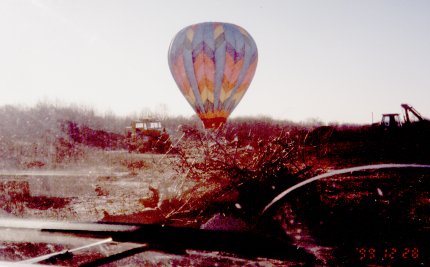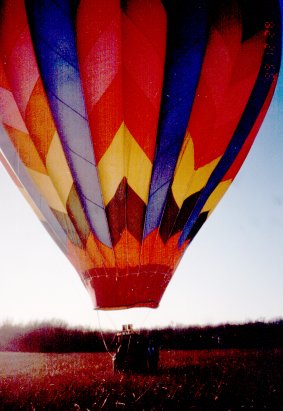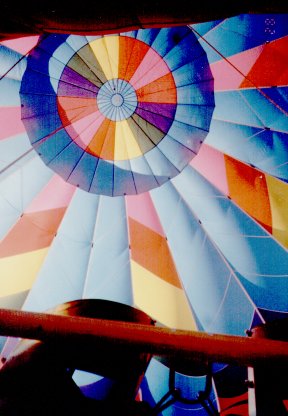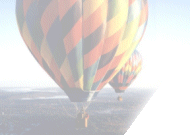
 | |
While the pilot deals with flying the balloon safely, the chase crew using a
combination of map-reading, experience and direct radio communication with the
pilot to follow the balloon as closely as possible using the available
roads. It works out best if the crew is present at the landing site before
the balloon touches down, or shortly afterwards.
 |
The balloon, just after
landing, as viewed from the chase vehicle as we arrive to help with
deflation and pack-up. This flight has been a little over an hour, a
typical length, and the balloon has landed in an open field behind a
housing development under construction. |
The crew then helps to deflate and pack up the balloon. The vehicle is,
of course, needed to transport the balloon, and its pilot and passengers back to
the launch site. On some landings, the balloon does not remain vertical,
typically due to high winds. In these cases, the pilot starts deflating
the balloon immediately before the basket strikes the ground, and the basket
turns on its side and drags a few feet before coming to rest.
 |
Another view of the balloon
on the ground after landing. In this case, the ground immediately
surrounding the landing point is not suitable for deflating the balloon
onto, as there are sharp shrubs and rocks. Instead, the pilot burns
a little to make the balloon light, and the crew picks up the basket and
"walks" the entire balloon to a more suitable spot about 50
yards away. It's also closer to the chase vehicle, which means less
distance to carry everything when we get it deflated! |
Once the balloon is in the correct position for deflation, the pilot pulls
the vent line and holds it open, releasing the hot air from the balloon.
One crew member takes the crown line and helps to pull the balloon horizontal,
also ensuring that it does not come down on top of the basket and the still-hot
burner.
 |
Looking up into the crown of
the balloon from just outside the basket as Robert pulls the vent line and
opens the parachute. You can see that the parachute has been pulled
down (inward) from the crown by the shadow cast by the open top of the
envelope onto the parachute. In the foreground is one of the burners
(this balloon has two). At the top of the picture is part of the
skirt of the balloon.
Within a minute or so after pulling the vent open,
the balloon is almost completely deflated.
|
Once the balloon is deflated, the remaining air is squeezed out by taking
armfuls of the fabric, starting at the mouth, and gathering it into a
"streamer" or "sausage", pushing any remaing air ahead and
out through the crown. The envelope bag is then brought to the crown, and
the "sausage" of fabric is placed into the back a few feet at a time,
as the bag is dragged closer to the basket. The packed-up envelope bag is
then placed in the trailer. Finally, the basket and its components are
disassembled and stowed, and the basket is also placed on the trailer, and all
components are tied down for the trip home.
Another flight completed - time for breakfast!
Back to Ballooning page |

